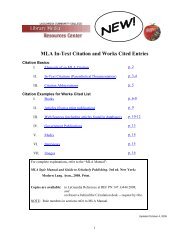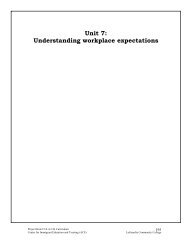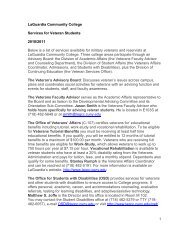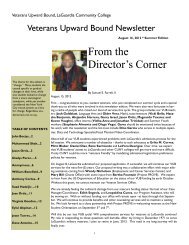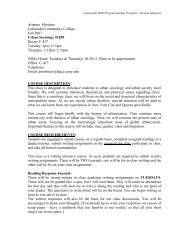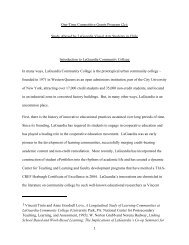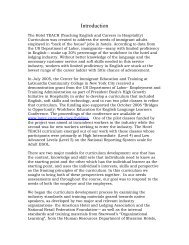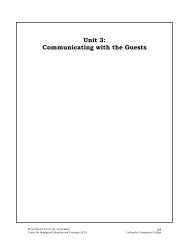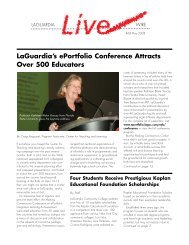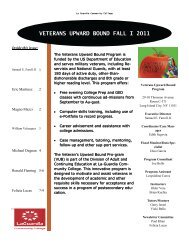Mathematics and ESL - Center for Teaching and Learning
Mathematics and ESL - Center for Teaching and Learning
Mathematics and ESL - Center for Teaching and Learning
You also want an ePaper? Increase the reach of your titles
YUMPU automatically turns print PDFs into web optimized ePapers that Google loves.
<strong>Mathematics</strong> <strong>and</strong> <strong>ESL</strong>: Common Ground <strong>and</strong><br />
Uncommon Solutions<br />
Prabha Betne (<strong>Mathematics</strong>) <strong>and</strong><br />
Carolyn Henner Stanchina (Education <strong>and</strong> Language Acquisition)<br />
This article emerges from our collaboration on<br />
a series of workshops <strong>for</strong> middle <strong>and</strong> high<br />
school teachers of mathematics struggling to<br />
teach English language learners (ELLs) who are,<br />
in turn, struggling to pass the <strong>Mathematics</strong> A<br />
Regents examination. It represents the initiation<br />
of a conversation about the crucial role of<br />
language comprehension in mathematics, the<br />
parallels between second language <strong>and</strong> mathematics<br />
acquisition <strong>and</strong> pedagogy, the roles of<br />
teachers, <strong>and</strong> the immense challenges facing<br />
an education system serving over 180,000 students<br />
classified as ELLs by the National Clearinghouse<br />
<strong>for</strong> English Language Acquisition, <strong>and</strong><br />
speaking some 165 languages as reported by<br />
the New York City Department of Education.<br />
St<strong>and</strong>ards<br />
During the 1990s, academic st<strong>and</strong>ards <strong>for</strong> high<br />
school graduation were revised, requiring all<br />
high school students, including English language<br />
learners, to pass five Regents examinations,<br />
including <strong>Mathematics</strong>, with a score of<br />
65 or above. Simultaneously, the <strong>Mathematics</strong><br />
Regents has undergone a major shift in focus<br />
from de-contextualized manipulation skills to<br />
contextualized problem-solving strategies. The<br />
common underlying assumption that math<br />
does not depend on language, that students can<br />
excel in math without language, no longer<br />
holds true. The new st<strong>and</strong>ard of mathematical<br />
literacy pre-supposes advanced language proficiency,<br />
<strong>and</strong> while this shift in focus is a positive<br />
re<strong>for</strong>m, it is clear that the more mathematics<br />
is embedded in language, the more it challenges<br />
English language learners.<br />
Our Questionnaire Results<br />
For the most part, these changes in assessment<br />
have not resulted in the type of collaborative<br />
dialogue between <strong>ESL</strong> <strong>and</strong> <strong>Mathematics</strong> teachers<br />
that could empower <strong>and</strong> enable <strong>Mathematics</strong><br />
teachers to cope with the special learning<br />
needs of English Language Learners. Analysis<br />
of a questionnaire we distributed to participants<br />
be<strong>for</strong>e the workshops indicated that<br />
while some teachers had developed strategies<br />
<strong>for</strong> addressing the students’ linguistic <strong>and</strong> cultural<br />
barriers to learning, many seemed to lay<br />
blame on the students <strong>for</strong> lacking critical thinking<br />
skills, lacking practice in math, lacking the<br />
ability to identify what was being asked in a given<br />
problem or to underst<strong>and</strong> teacher explanations,<br />
<strong>and</strong> <strong>for</strong> demonstrating an “unwillingness<br />
to catch up in English reading abilities.”<br />
What Makes the Language of Math So<br />
Difficult?<br />
It is clear that teachers need to be sensitized to<br />
the challenge ELL students face when reading<br />
word problems <strong>and</strong> learning mathematics. In<br />
an attempt to contextualize math, writers have<br />
used concepts that may be culture-specific;<br />
there<strong>for</strong>e, they are not part of the ELL students’<br />
schema knowledge, <strong>and</strong> not transparent enough<br />
to allow students to guess in context. The resulting<br />
word problems may deal with the Kentucky<br />
Derby, financial investments, high school<br />
proms, baseball <strong>and</strong> other contexts which may<br />
be unfamiliar to students, thereby impairing<br />
their reading comprehension. Because the language<br />
of math lacks the redundancy <strong>and</strong> paraphrase<br />
of natural language (Dale <strong>and</strong> Cuevas<br />
338), there are few clues to meaning. Again,<br />
normally activated reading strategies such as<br />
guessing in context, inferring <strong>and</strong> predicting,<br />
may not be transferable to reading in math.<br />
In addition, lexical, syntactic <strong>and</strong> semantic<br />
challenges abound in word problems, according<br />
to an analysis by Dale <strong>and</strong> Cuevas (332).<br />
Besides the specialized vocabulary, there are<br />
long noun phrases, complex collocations, confusing<br />
prepositions (“by” can be used to signal<br />
multiplication, addition <strong>and</strong> division), <strong>and</strong> cul-<br />
<strong>Mathematics</strong> <strong>and</strong> <strong>ESL</strong> • 1
tural differences in the symbolic denotations<br />
of mathematical processes. Also, while certain<br />
words designate specific math operations, (“less<br />
than” may indicate subtraction), the opposite<br />
may also be true: Hilda has 7 records. She has<br />
5 records less than David. How many records<br />
does David have? Since David has 7+5, “less<br />
than” indicates addition. (Chamot <strong>and</strong> O’Malley<br />
229).<br />
Syntactically, students must underst<strong>and</strong><br />
that they cannot read mathematical sentences<br />
as if they were natural language sentences. In<br />
algebra, <strong>for</strong> example, Cr<strong>and</strong>all, Dale, Rhodes<br />
<strong>and</strong> Spanos found “recurring errors in translations<br />
of the language of word problems into<br />
solution equations,” (Dale <strong>and</strong> Cuevas 334),<br />
indicating that students map the surface syntax<br />
of the problem statements onto their equations.<br />
Students translated the sentence, “The<br />
number a is five less than the number b” as<br />
a = 5 - b, instead of the correct translation<br />
a = b - 5. (Dale <strong>and</strong> Cuevas 335). Similarly,<br />
given the problem, “There are 6 times as many<br />
students as professors in the math department.<br />
Write an equation that represents this statement,”<br />
students typically write 6S=P because<br />
they follow the literal word order of the natural<br />
language sentence (Cocking <strong>and</strong> Mestre<br />
216).<br />
The frequent use of complex structures<br />
which are traditionally taught at higher levels<br />
of <strong>ESL</strong>, such as comparatives: “That car costs 5<br />
times as much as mine does,” passive voice: “X<br />
is defined to be equal to 0” (Dale <strong>and</strong> Cuevas<br />
334), <strong>and</strong> logical connectors which set up various<br />
relationships between parts of a text –<br />
including cause-effect, similarity, <strong>and</strong> logical<br />
sequence: “if…then, if <strong>and</strong> only if, such that...”<br />
– also contributes to the level of linguistic difficulty.<br />
Semantically, to underst<strong>and</strong> mathematical<br />
language, students must be familiar with discourse<br />
devices which signal reference in English.<br />
In the example provided by Dale <strong>and</strong><br />
Cuevas – “The sum of two numbers is 77. If the<br />
first number is 10 times the other, find the number.”<br />
– students need to underst<strong>and</strong> that there<br />
are 2 numbers, that “the first number” refers<br />
to one of those numbers, <strong>and</strong> the elliptical “the<br />
other” refers to the second number, whose value<br />
they have to find (336).<br />
What makes the language of math so difficult,<br />
then, is both the students’ lack of a cultural<br />
framework on which to build an underst<strong>and</strong>ing<br />
of the context of a problem, <strong>and</strong> their lack<br />
of familiarity with the discourse features of<br />
math texts. This brief description of the challenges<br />
inherent in solving mathematical word<br />
problems reflects the interactive nature of the<br />
learning process itself.<br />
Parallels Between Second Language<br />
<strong>and</strong> <strong>Mathematics</strong> <strong>Learning</strong><br />
Language learning <strong>and</strong> mathematics learning<br />
are both cognitive processes. They can be<br />
understood through a constructivist model in<br />
which meaning is derived through the interaction<br />
between one’s own background knowledge<br />
<strong>and</strong> experience (top-down processing) <strong>and</strong><br />
one’s ability to process the given task or decode<br />
text (bottom-up processing). These two processing<br />
modes are complementary; one can be<br />
used to compensate <strong>for</strong> weakness in the other,<br />
but each alone is insufficient in terms of successful<br />
learning <strong>and</strong> per<strong>for</strong>mance. They both<br />
develop through feedback.<br />
Top-down processing refers to higher-order<br />
thinking skills. In mathematics, this is revealed<br />
in conceptual underst<strong>and</strong>ing of structures <strong>and</strong><br />
patterns, appropriate application of basic arithmetic<br />
<strong>and</strong> algebraic operations <strong>and</strong> concepts.<br />
Similarly, in language learning, this translates<br />
as the activation <strong>and</strong> application of appropriate<br />
background knowledge to the creation of<br />
meaning. However, students capable of this level<br />
of underst<strong>and</strong>ing still need to rely on their<br />
bottom-up processing skills to ensure that their<br />
hypotheses are grounded in the details of the<br />
text.<br />
Bottom-up processing refers to lower level<br />
skills that must be practiced if automaticity is<br />
to be achieved. In mathematics, as in language<br />
acquisition, this is associated with rote learning:<br />
computational skills, memorizing facts <strong>and</strong><br />
<strong>for</strong>mulas, doing mechanical, de-contextualized<br />
arithmetic or grammar drills, <strong>and</strong> focusing on<br />
2 • In Transit
discrete elements often without the benefit of<br />
comprehension. Students who remain at this<br />
level of processing cannot be said to be thinking<br />
mathematically or using language <strong>for</strong><br />
authentic communicative purposes.<br />
This view of learning is process rather than<br />
product-oriented. It implies an explicit focus on<br />
learning strategy use <strong>and</strong> self-monitoring if learning<br />
competence is to be transferable. It implies<br />
actively listening to students be<strong>for</strong>e attempting<br />
to teach, taking into account their schema knowledge<br />
<strong>and</strong> expectations of how things work. It is<br />
incumbent on teachers to elicit <strong>and</strong> interact with<br />
students’ prior underst<strong>and</strong>ings, to mediate their<br />
difficulties so that a restructuring of students’<br />
knowledge may take place.<br />
The Common Methodological Debate<br />
In both <strong>ESL</strong> <strong>and</strong> <strong>Mathematics</strong> classrooms,<br />
deductive teaching clearly prevails. Students<br />
are repeatedly taught the rote skills of computation<br />
or grammar, despite disappointing<br />
results. The debate over the merits of a deductive<br />
versus an inductive approach goes on.<br />
Should teachers begin by building bottom-up<br />
skills in the hope that top-down, conceptual,<br />
procedural underst<strong>and</strong>ing will somehow magically<br />
follow? Or should they begin by ensuring<br />
the development of top-down processing while<br />
supporting the development of the necessary<br />
bottom-up skills?<br />
Uncommon Solutions<br />
Trends toward content <strong>and</strong> task-based methodology<br />
in <strong>ESL</strong> indicate a call <strong>for</strong> a departure from<br />
traditional deductive teaching. In mathematics,<br />
a statement in the Principles <strong>and</strong> St<strong>and</strong>ards<br />
document published by the National Council<br />
of Teachers of <strong>Mathematics</strong> in 2000 claims,<br />
“Solving problems is not only a goal of learning<br />
mathematics but also a major means of<br />
doing so” (Van de Walle 40). We argue that<br />
inductive, problem-based approaches provide<br />
a more authentic context <strong>for</strong> learning that is<br />
not separated from doing. These approaches<br />
are more learner-centered <strong>and</strong> engaging <strong>and</strong><br />
provide the window into students’ math <strong>and</strong><br />
language hypotheses that teachers need in<br />
order to skillfully determine the sources of student<br />
error. Teachers can then provide feedback<br />
at that crucial moment when a meaningful revision<br />
of hypotheses is apt to occur. We demonstrated<br />
this during our workshops with two<br />
problem-solving activities used to initiate lessons,<br />
one from an <strong>ESL</strong> grammar book (Badalamenti<br />
<strong>and</strong> Henner Stanchina 98) <strong>and</strong> one<br />
reported by Ball <strong>and</strong> Bass (91–94).<br />
By asking <strong>ESL</strong> students to study a picture of<br />
an apartment, decide who lived there, <strong>and</strong> justify<br />
their conclusion, the teacher was able to<br />
elicit numerous sentences showing a range of<br />
hypotheses on the structure: There is / there<br />
are, including “in the bedroom has dress,” “is<br />
a dress,” “there are have computer,” “there is<br />
the computer,” <strong>and</strong> “there is a coffee pot on the<br />
stove.” Similarly, by presenting the following<br />
problem: “Joshua ate 16 peas on Monday <strong>and</strong><br />
32 peas on Tuesday. How many more peas did<br />
he eat on Tuesday than he did on Monday?”<br />
(Ball <strong>and</strong> Bass 91), the teacher elicited six different<br />
problem-solving methods. The challenge<br />
<strong>for</strong> both the <strong>ESL</strong> <strong>and</strong> the <strong>Mathematics</strong> teacher<br />
lies in creating the task, identifying <strong>and</strong> interpreting<br />
student errors, using them to underst<strong>and</strong><br />
student learning, <strong>and</strong> making decisions<br />
about teaching. The advantage of this methodology<br />
<strong>for</strong> the learner is a more connected, deeper<br />
underst<strong>and</strong>ing.<br />
This approach also lends itself to a focus on<br />
writing to learn. The Principles <strong>and</strong> St<strong>and</strong>ards<br />
<strong>for</strong> School <strong>Mathematics</strong> support communication<br />
as an “essential part of mathematics <strong>and</strong><br />
mathematics education” (NCTM 60). The st<strong>and</strong>ards<br />
encourage language use, particularly <strong>for</strong><br />
second-language learners, in order to facilitate<br />
“communicating to learn mathematics <strong>and</strong><br />
learning to communicate mathematically”<br />
(NCTM 60).<br />
There are many ways teachers can help students<br />
integrate language development with the<br />
learning of mathematics. These include having<br />
students paraphrase word problems, create<br />
word problems, justify solutions, <strong>and</strong> explain<br />
procedures <strong>for</strong> problem solving.<br />
We plan to pursue our conversation about<br />
the relationship between language <strong>and</strong> math-<br />
<strong>Mathematics</strong> <strong>and</strong> <strong>ESL</strong> • 3
ematics learning. In particular, we would like<br />
to focus on the level of preparedness of mathematics<br />
teachers working with ELL students.<br />
Within this group, there are some teachers who<br />
are themselves non-native speakers of English,<br />
some who may have limited mathematical<br />
knowledge or pedagogical repertoires, <strong>and</strong><br />
some whose underlying assumptions <strong>and</strong><br />
beliefs about teaching <strong>and</strong> student failure may<br />
not promote learning. We hope, as well, to be<br />
able to continue our conversation with them<br />
to seek further uncommon solutions to the very<br />
difficult problems we face.<br />
Works Cited<br />
Badalamenti, Victoria, <strong>and</strong> Carolyn Henner Stanchina. Grammar Dimensions Book I Platinum Edition.<br />
Boston: Thomson Heinle, 2000. 98–99.<br />
Ball, Deborah L., <strong>and</strong> Hyman Bass. “Interweaving Content <strong>and</strong> Pedagogy in <strong>Teaching</strong> <strong>and</strong> <strong>Learning</strong> to<br />
Teach: Knowing <strong>and</strong> Using <strong>Mathematics</strong>.” Multiple Perspectives on <strong>Mathematics</strong> <strong>Teaching</strong> <strong>and</strong><br />
<strong>Learning</strong>. Ed. Jo Boaler. Westport: Ablex, 2000. 83–104.<br />
Chamot, Anna Uhl, <strong>and</strong> Michael J. O’Malley. The CALLA H<strong>and</strong>book: Implementing the Cognitive Academic<br />
Language <strong>Learning</strong> Approach. New York: Addison-Wesley, 1994. 222–250.<br />
Dale, Theresa Corasaniti, <strong>and</strong> Gilberto J. Cuevas. “Integrating <strong>Mathematics</strong> <strong>and</strong> Language <strong>Learning</strong>.”<br />
The Multicultural Classroom. Ed. Patricia A. Richard-Amato <strong>and</strong> Marguerite Ann Snow. New<br />
York: Longman, 1992. 330–348.<br />
“Division of English Language Learners.” NYC Department of Education. NYC Department of Education.<br />
2004 .<br />
Mestre, Jose P. “The Role of Language Comprehension in <strong>Mathematics</strong> <strong>and</strong> Problem Solving.” Linguistic<br />
<strong>and</strong> Cultural Influences on <strong>Learning</strong> <strong>Mathematics</strong>. Ed. Rodney R. Cocking <strong>and</strong> Jose P. Mestre. New<br />
Jersey: Lawrence Erlbaum Associates, 1988. 201–218.<br />
“New York Rate of LEP Growth 1993/1994–2003/2004.” National Clearinghouse <strong>for</strong> English Language<br />
Acquisition <strong>and</strong> Language Instruction Educational Programs. Office of English Language Acquisition,<br />
Language Enhancement, <strong>and</strong> Academic Achievement <strong>for</strong> Limited English Proficient Students.<br />
November 2004<br />
.<br />
“Position Statement: <strong>Mathematics</strong> <strong>for</strong> Second Language Learners.” National Council of Teachers of<br />
<strong>Mathematics</strong>. National Council of Teachers of <strong>Mathematics</strong>. July 1998<br />
.<br />
Van de Walle, John. Elementary <strong>and</strong> Middle School <strong>Mathematics</strong>: <strong>Teaching</strong> Developmentally. 4th ed. New<br />
York: Longman, 2001.<br />
4 • In Transit



